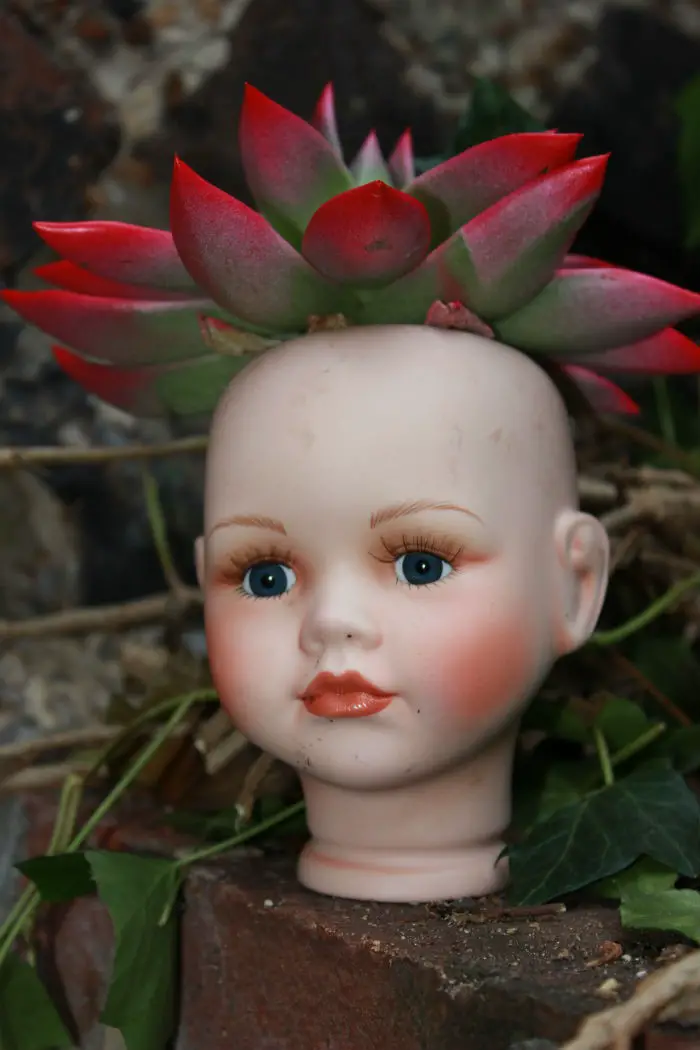35+ Types Of Spruce Trees And Shrubs For Landscaping
Spruces, belonging to the genus Picea, are a diverse group of evergreen plants renowned for their hardiness and adaptability. These versatile species not only add aesthetic value to landscapes but also serve as natural barriers, habitat providers, and windbreakers. With over 30 distinct types, spruces have become a popular choice among gardeners and landscapers due to their resilience and ability to thrive in various environments.
From Alcock’s spruce to Wilson’s spruce, each species offers unique characteristics that make them suitable for different climates, soil conditions, and purposes. Whether you’re looking to create a privacy screen or attract local wildlife, there’s a type of spruce tree or shrub to suit your needs.
Myths about spruce trees.
Spruce trees have long been shrouded in myths and superstitions. One common misconception is that they attract lightning, but the truth is that spruces don’t draw lightning any more than other tree species do. Another myth debunked by science is the claim that the sap of a spruce tree has healing properties – despite its popularity, there’s no evidence to support this notion.
Additionally, some believe that the scent of spruce needles can repel evil spirits, but unfortunately, this too lacks scientific backing. On top of these myths, many people also associate spruce trees with good fortune and prosperity, possibly due to their symbolic status as a representation of new beginnings in various cultures. While this sentiment is certainly appealing, there’s no concrete evidence to suggest that spruce trees actually bring about luck or prosperity.
Spruce tree identification.
Spruce trees are distinguished by their characteristic conical silhouette, characterized by horizontal branches and a slender crown. The distinctive feature of spruce needles is their four-sided cross section, terminating in sharp points. Notably, the foliage tends to be darker green compared to other evergreen species. Furthermore, cone shapes can vary depending on the specific spruce tree species, ranging from small and rounded to elongated and oval.
Spruce trees
Spruce trees are distinguished by their unique characteristics, which go beyond their distinctive bark. The bark of younger spruce trees is typically grayish-brown, gradually transitioning to reddish-gray or blackish-brown as they mature. Depending on the species, the bark may also feature scaly or furrowed patterns. But it’s not just the appearance that sets spruce trees apart – their fragrance is also a distinctive trait.
The aroma of a spruce tree can be detected from a distance and is often described as fragrant. Spruce trees are found in many parts of the world, including North America, Europe, Asia, and Russia. With over 30 species to choose from, each with its own unique characteristics, it’s no wonder that these trees have captured the imagination of people around the globe. Different varieties can be identified by their color, shape, needle size, and texture.
Norway Spruce, Blue Spruce, Black Spruce, White Spruce, Red Spruce, and Sitka Spruce are just a few examples of the many species of spruce trees that exist.
Spruce shrubs.
Spruce shrubs, often overlooked in favor of their tree counterparts, offer a unique set of benefits for landscaping. These compact, low-growing plants are commonly used to create hedges or as accent pieces in rock gardens. Like spruce trees, they feature four-sided, sharp needles and cones that mirror those of the taller specimens.
A few popular species of spruce shrubs include the Dwarf Alberta Spruce (Picea glauca ‘Conica’), which is ideal for border planting and container gardens due to its slow growth rate. Another popular option is the Bird’s Nest Spruce (Picea abies ‘Nidiformis’), characterized by a low, spreading habit that makes it an excellent groundcover. Other varieties of spruce shrubs include the Black Hills Spruce (Picea glauca ‘Densata’) and the Meyer’s Spruce (Picea meyeri).
Types of Spruce Trees and Shrubs: A Closer Look
Alcock’s spruce (Picea alcoquiana)
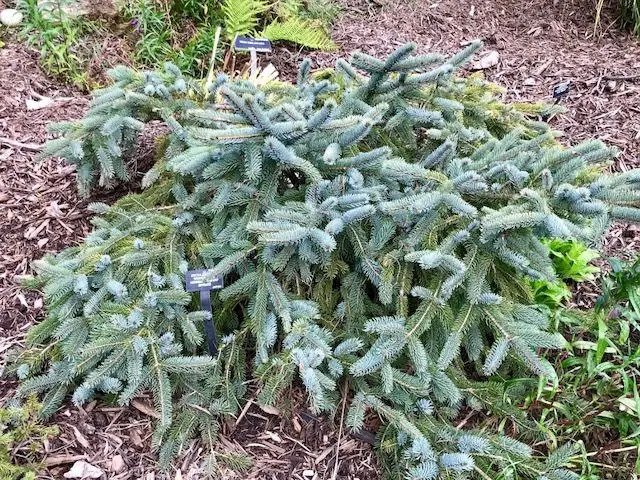
Alcock’s spruce, a native Pacific North American evergreen, boasts a slow-growing yet striking presence. Its pyramidal shape reaches heights of 20 feet on average, with some specimens growing up to 40 feet tall over time. The species thrives in well-drained acidic soil with a pH range of 4.5-6 and prefers full sun to partial shade. Notably, its 1-2 cm long needles boast a distinctive blue-green hue with a waxy coating on the underside, offering natural protection from the elements.
While often utilized as an ornamental tree due to its attractive appearance, Alcock’s spruce also excels at windbreaks or shelterbelts, tolerating prolonged exposure to high winds and cold temperatures. Its low-maintenance requirements, adaptability to most soil types, and unique characteristics make it an excellent choice for adding year-round beauty to any landscape.
Bird’s Nest Spruce (Picea abies ‘Nidiformis’)
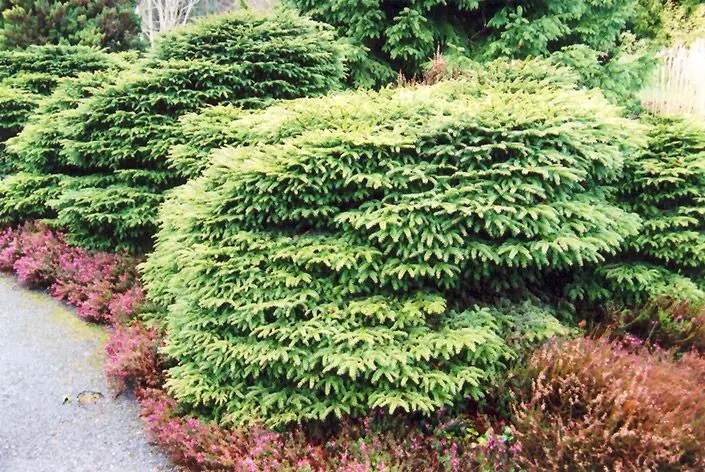
The Bird’s Nest Spruce, a unique evergreen conifer, showcases a rounded, dwarf form that grows at a moderate rate of around 5 inches per year, eventually reaching 2 to 3 feet tall with a spread of approximately 4 feet. This slow-growing tree thrives in moist but well-drained, acidic soil and tolerates urban pollution, making it an excellent choice for city gardens. The ideal pH range for this plant is between 4.5 and 6.5.
Its most striking features include the upturned lower branches that create a nest-like shape, giving it its distinctive name. Additionally, it boasts twisted blue-green foliage and reddish-brown bark with scales, adding textural interest to any landscape. As for maintenance, Bird’s Nest Spruce is remarkably low-maintenance, requiring little pruning or fertilization; occasional protection from strong winds may be necessary.
This variety of spruce tree is highly sought after for ornamental use, rock gardens, borders, and containers. It also serves as a valuable resource for wildlife, providing shelter and sustenance for birds and squirrels.
Black Spruce (Picea mariana)
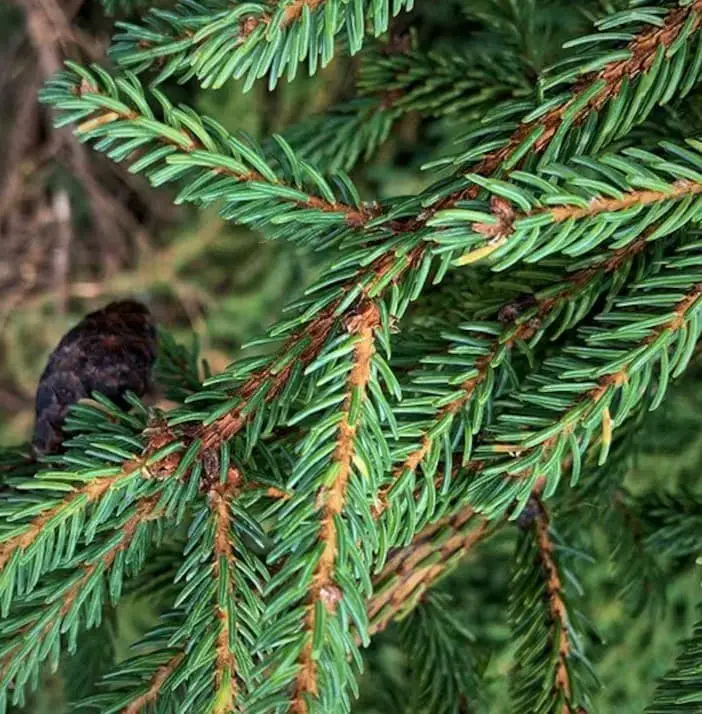
Black Spruce (Picea mariana) is a ubiquitous evergreen conifer that thrives across northern North America, favoring moist, acidic soils. Its remarkable adaptability allows it to reach heights of up to 25 meters, making it an iconic feature in the region’s boggy landscapes. The tree’s pH tolerance range is impressively broad, spanning from 4.5 to 50, rendering it well-suited for bogs and other acidic wetlands.
In terms of light requirements, Black Spruce exhibits a versatile nature, thriving in partial shade but also capable of surviving in full sun as well as deep shade. One of the most striking aspects of Black Spruce is its unique growth habit, characterized by a conical shape with long, slightly drooping branches that often hang down from the crown. This distinctive feature sets it apart from other conifers found in the same habitat.
The tree’s bark undergoes an intriguing transformation as it matures, transitioning from thin and smooth on young trees to thicker, furrowed bark on older specimens. Meanwhile, its needles are short and rectangular with sharp points at the tips, featuring a striking contrast between their dark green upper surfaces and blue-green lower surfaces.
The wood of Black Spruce is notable for its lightness and softness, making it an attractive material for various applications such as paper pulp production, furniture construction, firewood, charcoal, and other forms of fuel. Notably, the tree’s wood also emits a pleasant aroma when burned, further enhancing its appeal. Perhaps most surprisingly, Black Spruce is also used in the flavoring of certain foods and beverages, showcasing its versatility and value beyond traditional timber uses.
Brewer Spruce (Picea breweriana)
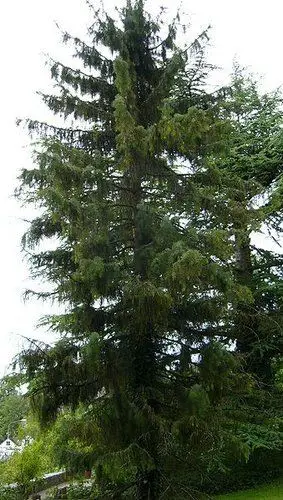
The Brewer Spruce (Picea breweriana) is a striking evergreen conifer that thrives in the western United States and Canada. Its robust, pyramidal growth habit is characterized by strong horizontal branching, showcasing its ability to thrive in diverse environments. The tree’s foliage is comprised of bright green needles, while its reddish-brown bark adds a pop of color to its profile.
This resilient species prefers well-drained, acidic soils with a consistent moisture level, typically found near streams or mountain slopes. While it excels in full sun, the Brewer Spruce can adapt to partial shade. Its optimal pH range lies between 5.5 and 6.5, allowing it to flourish in a wide range of soil conditions. The tree’s tolerance for warm summers and cold winters is impressive, with temperatures above -30°F posing no significant threat.
Once established, the Brewer Spruce demonstrates moderate drought tolerance, making it an excellent choice for gardeners seeking a hardy and disease-resistant tree. Its unique features include its vibrant yellow or red cones, which remain intact throughout the year, and twisted needles offering a distinct texture that sets it apart from other spruces.
Burmese spruce (Picea farreri)
The Burmese spruce (Picea farreri) stands tall as an evergreen conifer native to the eastern Himalayas in Southeast Asia. Its pyramidal shape boasts elegant branches that rise from a slender trunk, adorned with short, bluish-green needles and reddish-brown bark that’s thinly scaled. This resilient species thrives across a broad range of soils, provided they drain adequately. It flourishes in moist, well-drained soil, basking in full sun to partial shade, with an ideal pH range of 5.5 to 6.0.
With its rapid growth rate and natural pest resistance, the Burmese spruce is a low-maintenance gem for gardeners everywhere. As it matures, the tree’s bark develops striking silver stripes, a unique feature that deepens in intensity over time, eventually forming an impressive pattern. Its adaptability to both frigid and sweltering temperatures makes it an excellent choice for gardeners of all climates.
Caucasian or Oriental spruce (Picea orientalis)
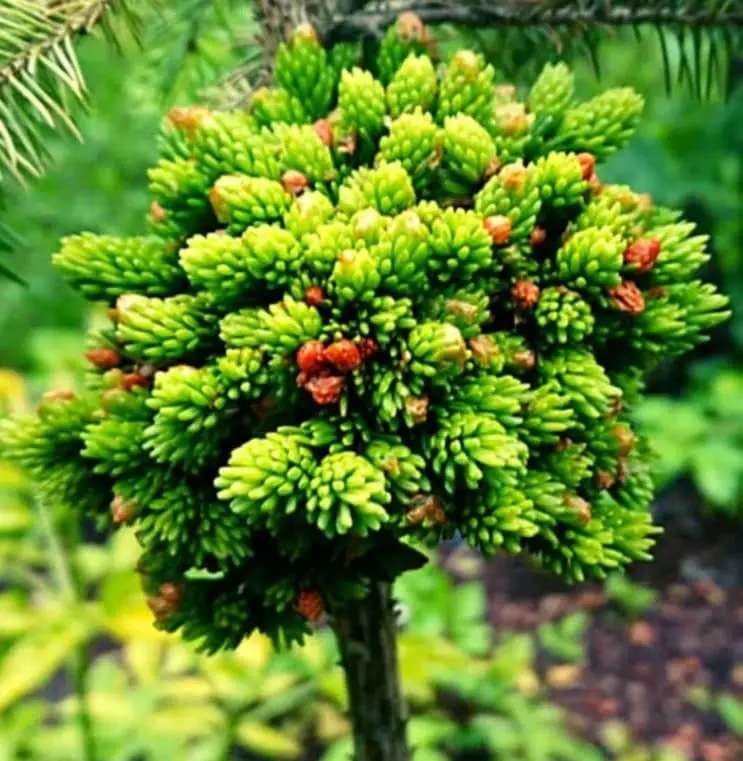
The Oriental spruce (Picea orientalis) is a medium to large tree that typically reaches heights of 40-60 feet with a pyramidal shape. Its dense branches are adorned with bright green needles that measure 2-4 inches in length. This species excels in environments with moist, well-drained soils and can thrive in both acidic and alkaline pH conditions. While it prefers full sun, it is also adaptable to partial shade.
Winter hardiness and drought resistance are notable features of this tree once established. As the tree matures, its bark takes on a rough gray color with orange highlights. The cones themselves are a distinguishing feature, measuring 2-4 inches in length and initially reddish-brown before transitioning to a purple-gray hue as they mature.
Chihuahua spruce (Picea chihuahuana)
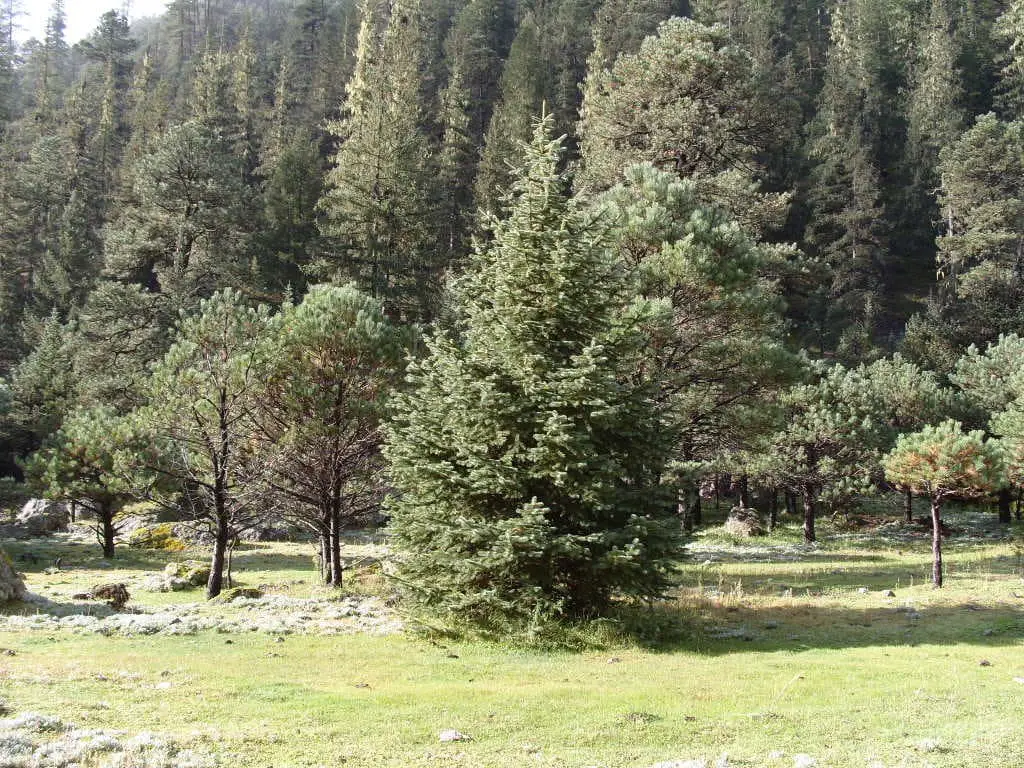
Native to Mexico’s Sierra Madre range, Chihuahua spruce (Picea chihuahuana) thrives in high-altitude environments with optimal conditions. This slow-growing coniferous tree exhibits a pyramidal growth pattern and reaches heights between 30-40 feet (9-12 m). Its short, bright green needles set it apart from other spruce species, while its cylindrical cones measure approximately 1 inch (2.5 cm) in length.
Chihuahua spruce prefers moist, well-drained soils with slightly acidic pH levels ranging from 5.0 to 6.0. Although it thrives in full sun, it can tolerate some shade. This species’ remarkable resilience allows it to flourish in northern climates, where it tolerates ice and snow. The Chihuahua spruce’s standout features include its attractive blue-green foliage and appealing form.
Beyond its ornamental value in landscaping, this species is prized in the timber industry for its strength and durability. Its value as wildlife habitat cannot be overstated, providing shelter and sustenance for a diverse range of animals.
Colorado spruce or blue spruce (Picea pungens)
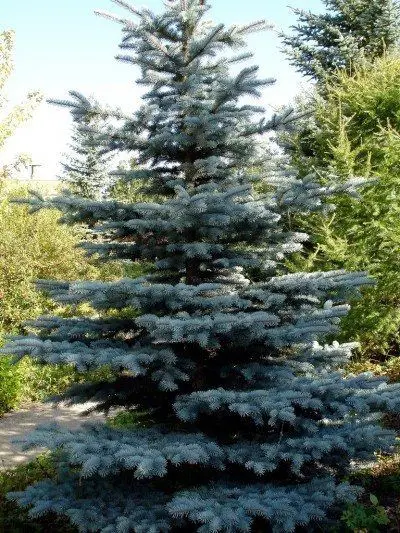
The Colorado spruce, a. k. a. blue spruce (Picea pungens), is an evergreen native to North America’s Rocky Mountain region. This coniferous tree boasts a pyramidal shape and dense foliage that transitions from blue-green to silvery-gray depending on its environment. Its growth rate is moderate, reaching 40-50 feet in height with a 20-30 foot spread upon maturity. Notably, it thrives in a broad range of soils but excels when planted in moist, well-drained soil with a pH between 5.0 and 8.
0, all while basking in full to partial sunlight for optimal growth.
Unique to this evergreen is its dense, fragrant foliage, comprising soft blue-green needles that stretch 4-6 inches long. The tree’s bark begins as smooth grayish-brown when young, gradually becoming scaly and furrowed with age. Additionally, it produces light brown conelike fruits containing its seeds.
Dragon spruce (Picea asperata)
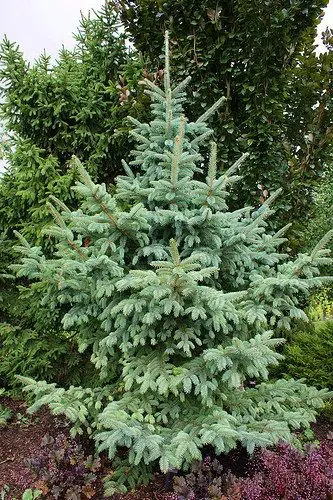
With its conical to pyramidal habit and bright green foliage, the dragon spruce (Picea asperata) is a striking evergreen that can grow up to 25-35 feet tall in ideal conditions. When container-grown, it typically reaches heights of 10-20 feet. Its light gray bark adds an attractive textural element to its overall appearance. This tree thrives in acidic soil with consistent moisture and a pH range of 5.5-6.5.
While it prefers full sun, it can tolerate partial shade as long as the soil remains moist. One of its most distinctive features is its needle-like foliage, featuring single-pointed leaves that resemble a dragon’s tooth. The stiff branches, which often droop downwards, contribute to the tree’s pyramid-like shape. Additionally, the dragon spruce is surprisingly drought-tolerant once established, making it a low-maintenance option for gardeners.
Dwarf Alberta Spruce (Picea glauca ‘Conica’)
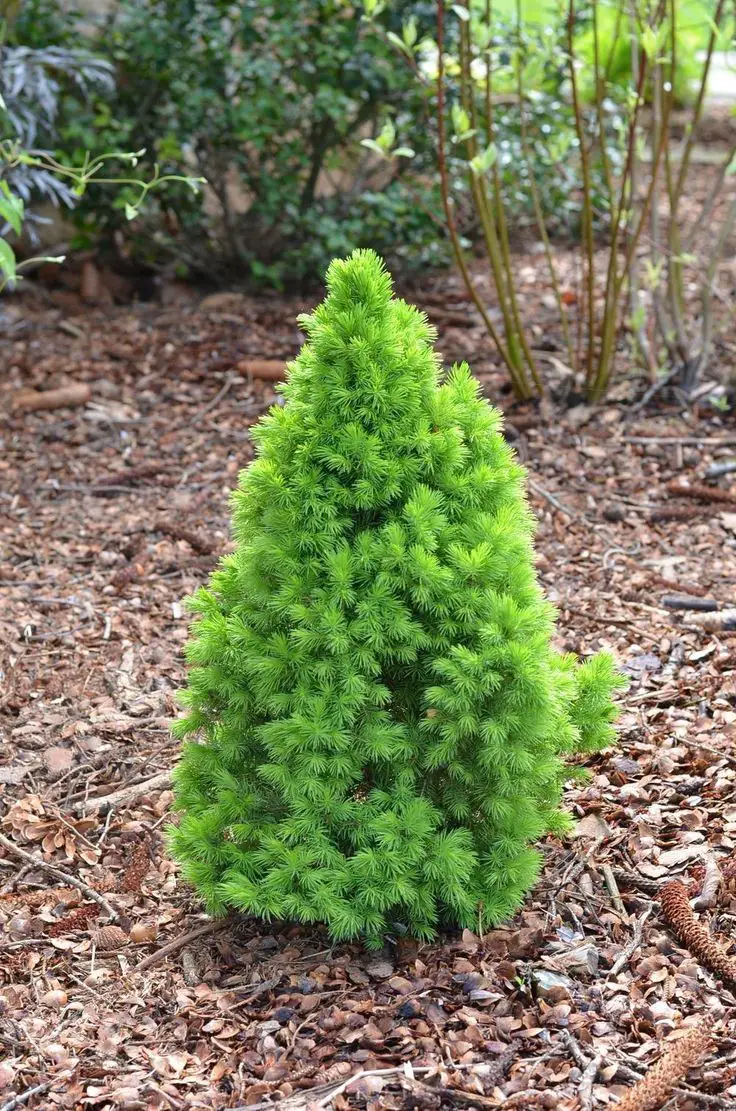
The Dwarf Alberta Spruce (Picea glauca ‘Conica’) is a compact coniferous shrub that can grow up to 10 feet tall with a slender, conical shape. Its bright green needles adorn its branches, making it an attractive addition to any garden. This species thrives in acidic, moist soils with a pH range of 5.5 to 6.8 and can tolerate both sun and shade, although it excels when planted in full sunlight.
One of its unique characteristics is its ability to retain its shape without pruning or shearing, a feature not all conifers share. The Dwarf Alberta Spruce also boasts a slow to moderate growth rate and exceptional tolerance for cold temperatures, making it an ideal choice for cooler climates. Interestingly, this species only begins producing cones once it reaches at least 10 years of age.
Dwarf Blue Spruce (Picea pungens ‘Globosa’)
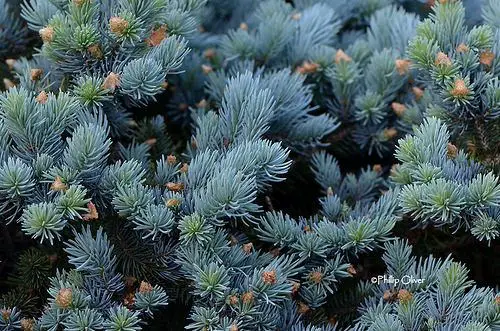
Dwarf Blue Spruce, an evergreen shrub with a rounded mounding form, typically grows to 4-6 feet tall and 6-8 feet wide. While it thrives in moist, well-drained soils with full sun to partial shade, its adaptability allows it to tolerate a range of soil types and pH levels. Specifically, it prefers slightly acidic soil conditions between 6.0-7.5, but can adjust to variations outside this range.
This tree excels when situated in full sun, which enables it to showcase vibrant foliage color and maintain its shape. Unique features include its silvery-blue foliage, which retains its blue hue even in cold temperatures, adding winter interest to landscapes. Additionally, Dwarf Blue Spruce is remarkably tolerant of wind and drought conditions once established. Its low-maintenance requirements mean minimal pruning is needed for shape maintenance.
This versatile tree can be used as a specimen plant, grouped or massed for screening purposes, making it an excellent choice for erosion control areas and deer-resistant landscaping.
Dwarf Norway Spruce (Picea abies ‘Conica’)
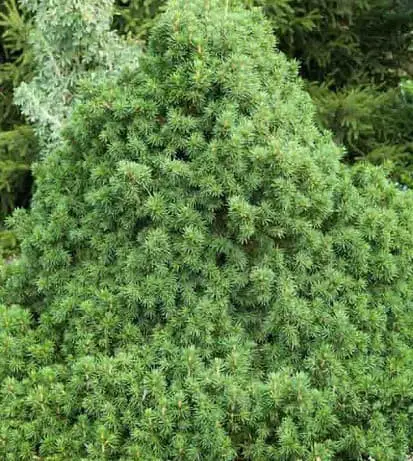
The Dwarf Norway Spruce (Picea abies ‘Conica’) is a compact, evergreen conifer that boasts a dense, pyramidal shape and short, vibrant green needles. Its slow growth rate allows it to reach heights of up to 6 feet after 10 years, with a width of 2-4 feet. This resilient tree thrives in USDA hardiness zones 3-7.
This spruce species prefers moist, well-drained soils with a pH range of 5.0 to 7.5, but it also tolerates a broad spectrum of soil types.
To achieve optimal growth, provide full sun and moderate wind protection.
One of its most striking features is its attractive blue-green foliage, which remains on the plant year-round, adding depth and visual interest to any landscape. Additionally, this evergreen boasts impressive pest and disease resistance, drought tolerance, and can be used as an accent or screening tree.
Overall, the Dwarf Norway Spruce is a low-maintenance yet high-impact addition to any garden, offering a unique blend of beauty and functionality.
Engelmann’s Spruce (Picea engelmannii)
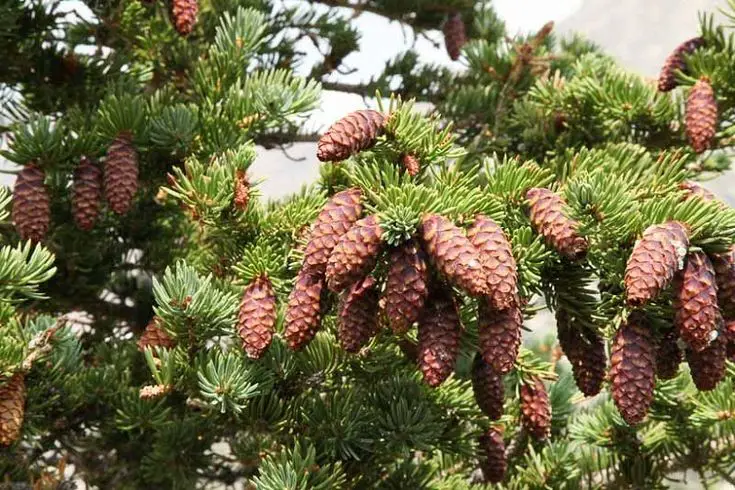
Engelmann’s Spruce (Picea engelmannii) is a coniferous evergreen tree that calls western North America home. It develops into an impressive pyramidal shape and can reach mature heights of 30-60 feet, with a spread of 10-20 feet. The tree thrives in moist soils with a pH range of 5.0 to 7.5 and exhibits optimal growth when basking in full sun; it’s also surprisingly tolerant of partial shade, wind, and even sea-salt spray.
One of its most striking features is the dense foliage that transforms from light green in summer to silvery blue in winter. The reddish-brown bark becomes scaly and furrowed with age, adding character to the tree’s overall appearance. Notably, the Engelmann spruce produces cones measuring 1-2 inches in length, containing seeds just 6-8 millimeters long. Its unique wood structure has made it a popular choice for crafting tonewood used in musical instruments like guitars and violins.
This slow-growing tree can live up to 750 years in its natural habitat, making it an enduring presence in the wild, growing at a rate of approximately 12 feet per year.
Glehn’s spruce (Picea glehnii)
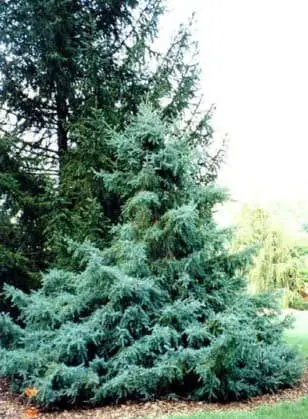
Glehn’s spruce (Picea glehnii) is a compact, evergreen conifer native to Japan, boasting a striking pyramidal shape and dense foliage. Reaching heights of up to 20 feet with a spread of 15 feet, this slow-growing species thrives in well-drained soil that is neither too wet nor dry. Its ideal pH range lies between 5.5 and 7.0. While it prefers full sun, Glehn’s spruce can also tolerate light shade and is suitable for USDA Hardiness Zones 4-6.
This conifer stands out due to its remarkable needle retention. Unlike many evergreens that shed their needles within a few years of growth, Glehn’s spruce retains them for more than three years, making it an excellent choice for gardens with no-needle-drop policies. Furthermore, the species’ needles remain vibrant and green year-round, providing a striking contrast to other evergreens in mixed plantings.
Its deep green hue is particularly noteworthy, as it adds depth and visual interest to any garden or landscape.
Green dragon spruce (Picea retroflexa)
The Green dragon spruce (Picea retroflexa) boasts a unique combination of striking features and practical benefits, making it an attractive addition to any landscape. Native to China’s and Tibet’s mountainous regions, this evergreen conifer exhibits a distinctive pyramidal shape during its youthful stages, gradually transforming into a more pointed silhouette as it matures.
Its narrow, densely packed foliage offers excellent privacy screening, rendering it an ideal choice for home landscapes seeking seclusion.
Growth-wise, the Green dragon spruce is characterized by slow growth, with average heights ranging from 10 to 15 feet and widths of 8 to 10 feet. Upon reaching maturity, this tree can attain impressive heights of up to 50 feet.
In terms of soil requirements, the Green dragon spruce thrives in environments with moist, well-drained conditions, though it is capable of tolerating dry conditions as well. Ideally, it prefers a pH range of 5.5 to 7.0.
Lighting-wise, this tree flourishes under full sun or partial shade, requiring at least four hours of direct sunlight daily.
Among its standout features are the Green dragon spruce’s exceptional resistance to pests and diseases, necessitating minimal pruning efforts.
Its evergreen foliage boasts a beautiful blue-green hue, while its bark takes on an attractive orange-red color as it matures. The tree’s needles exhibit a pleasant pine scent when crushed and possess a sharp texture.
Korean spruce (Picea koraiensis)
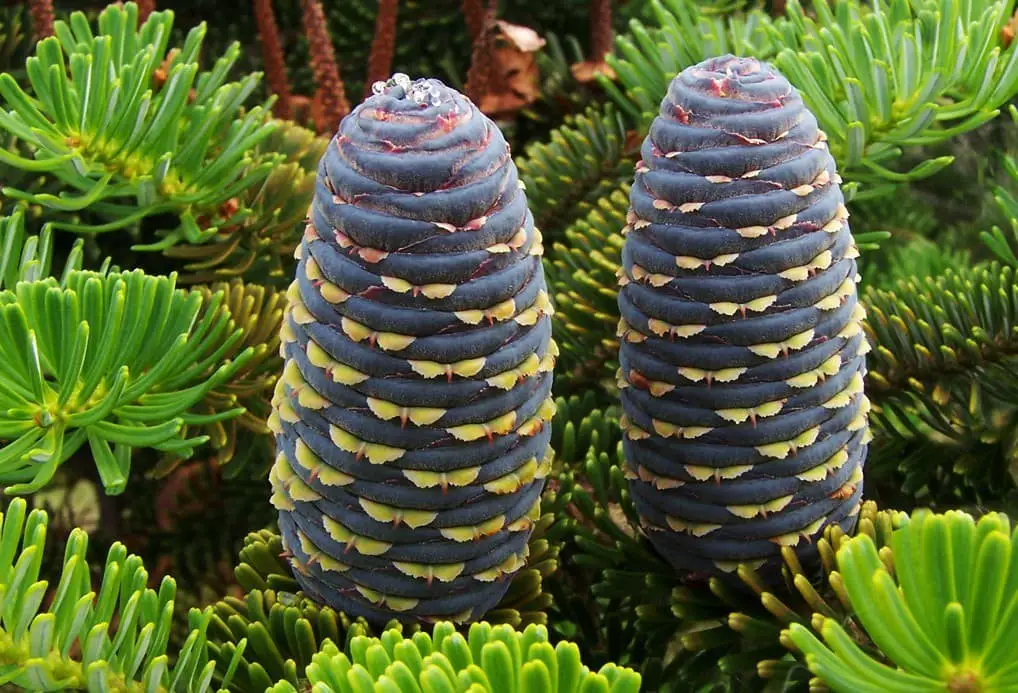
The Korean Spruce (Picea koraiensis) stands out as a majestic evergreen conifer, boasting a pyramidal shape and native to eastern Asia. While its growth rate may be slow, it can still reach impressive heights of up to 30 meters (100 feet) tall, with a sprawling width of around 10 meters (35 feet). The tree’s branches are stiffly arranged in a pyramidal formation that gradually tapers at the top.
When it comes to growing conditions, the Korean Spruce thrives in well-drained, acidic soils with a pH range of 4.5 to 6.0. It requires full sun or partial shade and has moderate drought tolerance once established. Notably, this tree is relatively disease-free, but may be susceptible to scale insects and spider mites.
Koyama’s spruce (Picea koyamae)
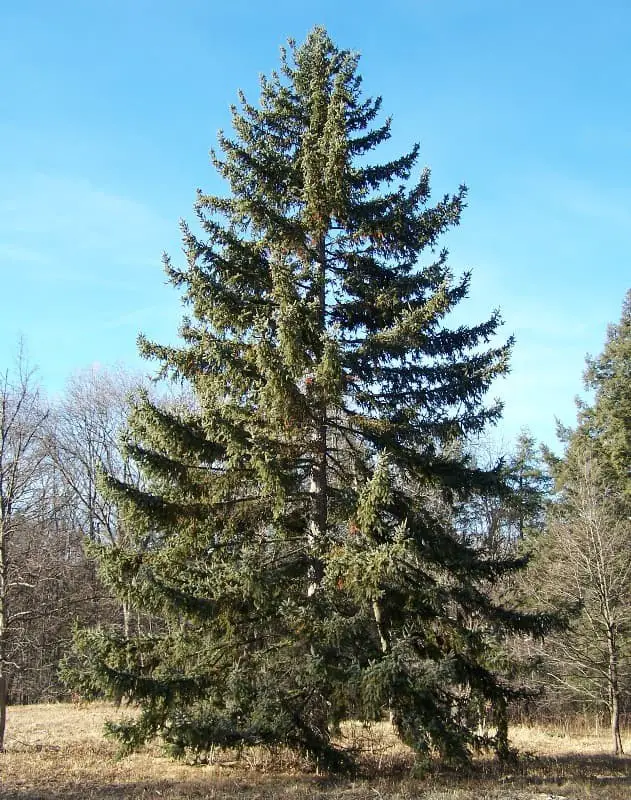
Koyama’s spruce (Picea koyamae) is a medium-sized coniferous tree endemic to Japan, exhibiting a pyramidal growth habit with spreading branches and deep green needles reminiscent of its closely related Siberian counterpart. The species typically reaches 25 feet in height, but can grow up to 40 feet tall under optimal conditions.
This evergreen prefers well-drained, acidic soils with a pH range of 4.5 to 6.5, and requires full sun exposure to thrive.
Notably, it can withstand temperatures as low as -20°F (-29°C) and displays remarkable resilience to drought and pest pressures. In addition to its year-round verdant foliage, Koyama’s spruce boasts a striking silver-blue hue during winter months when temperatures drop below freezing, making it a popular ornamental choice for parks, gardens, and backyards.
Meyer’s spruce (Picea meyeri)
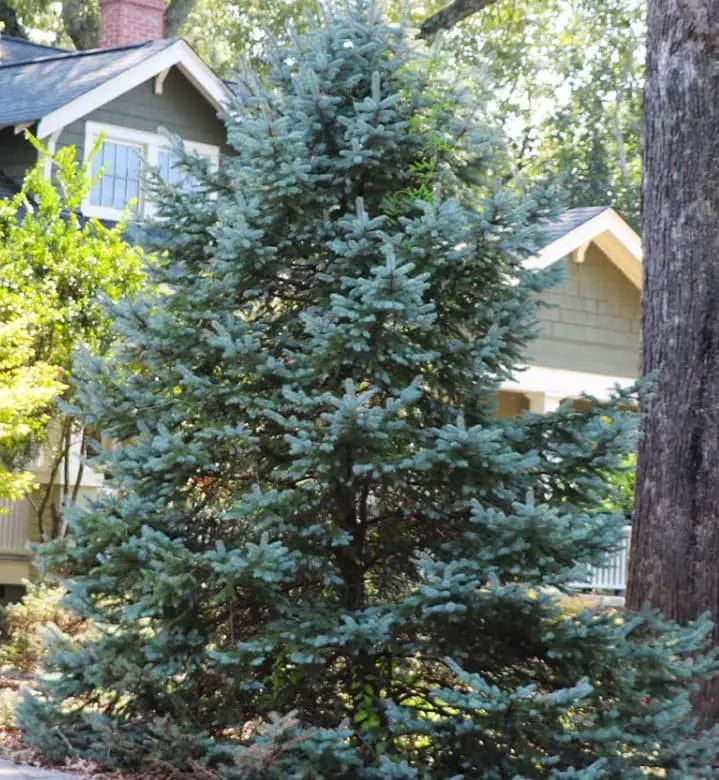
Meyer’s spruce trees are characterized by their shrub-like coniferous evergreen nature, with a rounded pyramidal shape that can grow up to 20 feet tall. The tree is distinguished by its dark green needles, which appear in dense clusters and produce small cones. When it comes to soil preferences, Meyer’s spruce thrives in moist, well-drained conditions, such as sandy loam or silt loam, with a slightly acidic pH range of 5.5-7.0.
Full sun exposure is essential, although the tree can tolerate cooler climates and temperatures as low as -20°F (-28°C). One of the unique advantages of Meyer’s spruce is its exceptional drought resistance, making it an excellent choice for dry areas. Additionally, the tree exhibits relatively rapid growth rates, reaching maturity in just five years. Its vibrant green foliage also provides year-round visual interest and beauty to any landscape.
Morinda spruce (Picea smithiana)
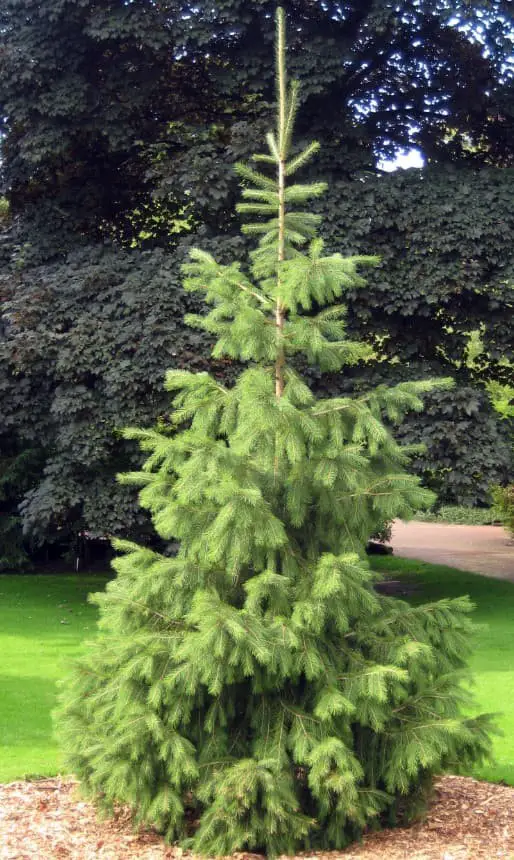
Morinda spruce (Picea smithiana), an evergreen native to western North America, presents a striking visual profile. Its pyramidal shape reaches heights of 40-50 feet tall and 15-20 feet wide, with dark green needles measuring approximately one inch in length and featuring a subtle curvature and sharp point. The tree’s bark is characterized by a distinctive grayish-brown coloration, adorned with scales. In terms of growth habit, Morinda spruce exhibits a steady, albeit slow, pace.
It can take up to 10 years for the tree to reach its full height, after which it will continue to grow at a rate of an inch or two per annum. The tree’s soil preferences are well-drained, acidic environments with a pH range of 4.5-6.0. Morinda spruce also thrives in areas receiving full sun exposure, although it can tolerate partial shade if necessary. One of the tree’s most notable features is its elegant appearance, courtesy of the dark green needles and grayish-brown bark.
Additionally, Morinda spruce boasts natural resistance to many diseases and pest problems, making it an attractive choice for gardeners seeking a low-maintenance addition to their landscaping endeavors.
Norway spruce (Picea abies)
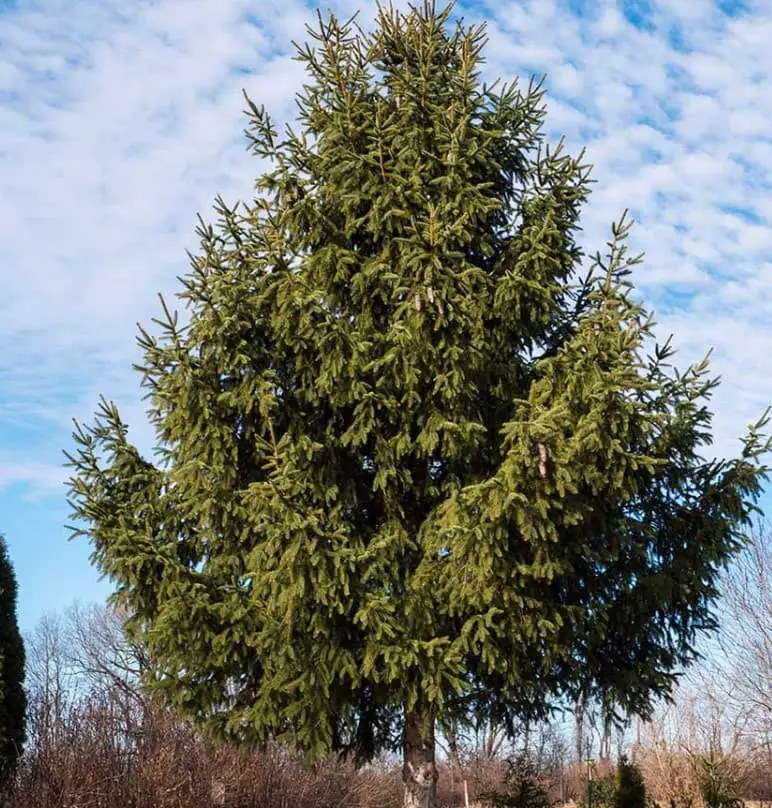
The Norway spruce, a native evergreen coniferous tree of northern Europe and parts of Asia, boasts a range of attractive features that make it a popular choice for landscaping. Its rapid growth rate and adaptability to harsh climates have earned it a special place in many gardens. At maturity, the Norway spruce can reach heights of up to 100 feet, with a trunk diameter of up to 3 feet. Its youthful conical shape gives way to a broad-pyramidal form as it matures.
The Norway spruce thrives in moist, well-drained soils with a pH range between 4.5 and 7, but its hardiness also allows it to tolerate drier conditions and partial shade. However, it will perform best when provided with full sun. One of the tree’s most distinctive features is its long, dark green needles, which measure around 1-2 inches in length and have a unique four-sided shape with blunt tips.
The Norway spruce is also notable for its abundant cones, which hang downward and have a reddish-brown hue.
Oriental Spruce, Caucasian Spruce (Picea orientalis)
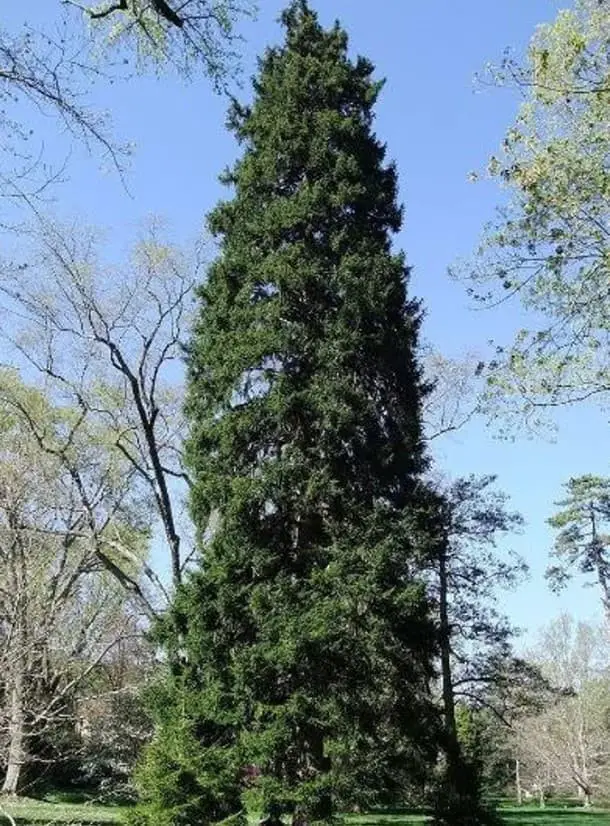
The Oriental Spruce tree, a coniferous evergreen, can grow up to 30 meters tall with a pyramidal shape in its youth, gradually transforming into a more sprawling or irregular form as it matures. Native to southeastern Europe and western Asia, this tree is now widely cultivated beyond its native range for its ornamental value.
Its ability to thrive in well-drained soils that are neither too wet nor dry, coupled with its tolerance of a broad pH spectrum, makes it an attractive choice for many gardeners. While full sun is ideal, the Oriental Spruce can also tolerate partial shade, providing a degree of flexibility when selecting a planting location.
Purple cone spruce (Picea purpurea)
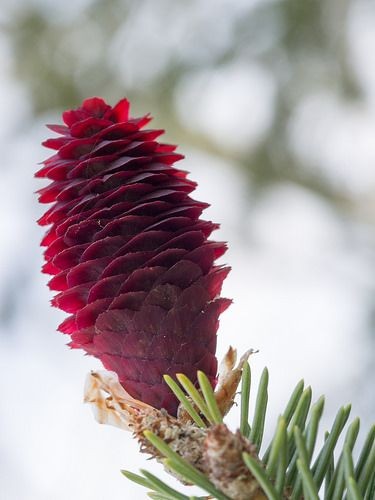
The purple cone spruce (Picea purpurea) stands out with its distinctive conical shape, reaching heights of 10-20 feet with a width of 3-4 feet. Some species can grow up to 40 feet tall, showcasing the tree’s adaptability. The sharp, blue-green needles and reddish-brown bark set it apart from other conifers. Notably, its cones are primarily purple in color, earning the tree its name. This species thrives in cooler climates with damp soil and good drainage, preferring a pH range of 5.0 to 7.
5 and full sun for optimal growth. While tolerating some shade in hotter areas, it requires sufficient sunlight to flourish. The tree’s unique features include dense foliage and vibrant purple cones, which can occasionally turn yellow or green depending on the species. Its thick bark also provides impressive fire resistance, making it an ideal choice for areas prone to wildfires.
Moreover, the wood is robust and resistant to splitting, rendering it a popular selection for construction in certain regions.
Red spruce (Picea rubens)
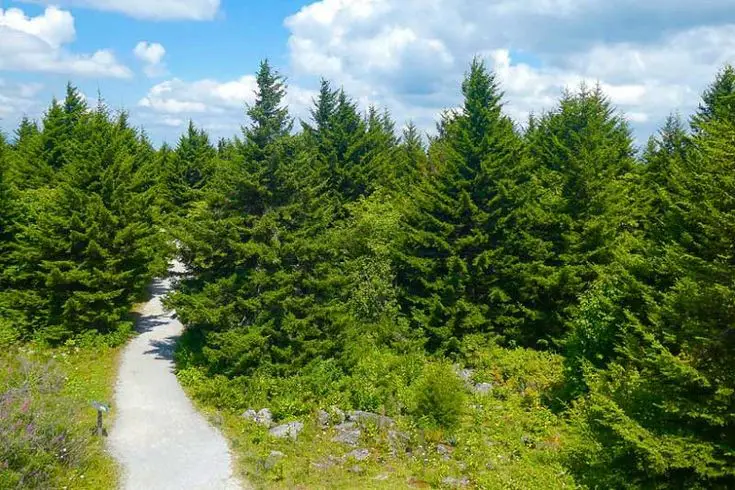
Red spruce (Picea rubens) is a coniferous evergreen tree characterized by its pyramidal shape, open crown, and horizontal branches that gradually droop at the tips. The tree’s gray to reddish-brown bark features small, yellow-green buds, while its short, four-angled needles measure approximately half an inch in length. With a slow growth rate, red spruce exhibits an upright, open form and can thrive in both shaded and sunny conditions.
Its ideal environment includes moist, well-drained soil rich in organic matter, with a preferred pH range of 4.5 to 6.0. This adaptable species excels in full sun but also tolerates partial shade. One of its most notable features is the high-quality wood, renowned for its lightness, strength, and straight grain, making it an excellent choice for construction and furniture crafting.
As an ornamental tree, red spruce offers year-round interest due to its striking bark and evergreen foliage, while also providing valuable cover for wildlife.
Sargent’s spruce (Picea brachytyla)
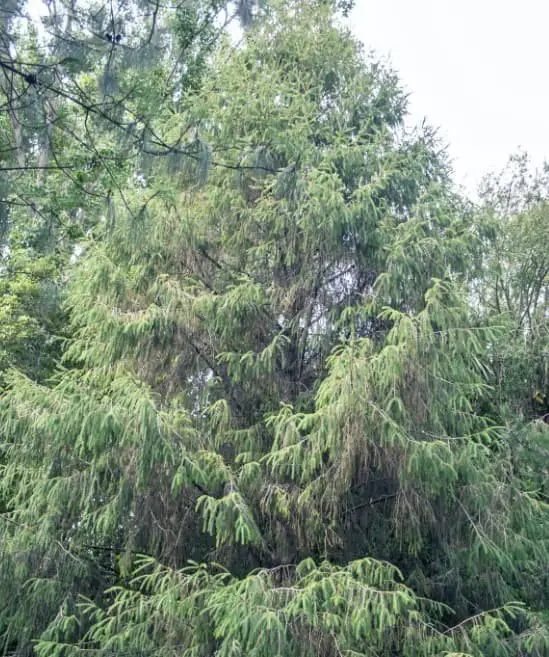
Sargent’s spruce is a stalwart evergreen coniferous tree that thrives in North America. Its distinctive pyramidal shape is characterized by dense branching and strong, upright leaders, which can reach heights of up to 80 feet under ideal conditions. The tree’s spread is equally impressive, measuring between 15-30 feet. This species excels in environments with moist, well-drained loam soils and a pH range of 5.5-7.5.
It also flourishes in partial to full sunlight exposure, although it can tolerate some shade from other trees. Sargent’s spruce is surprisingly resilient, tolerating wind, salt, temperatures as low as -40°F, and even drought. One of the tree’s most striking features is its bright green needles, which are complemented by glossy bark and pinkish cones. The young bark is scaly and cinnamon-colored, adding a delightful texture to the landscape.
Sargent’s spruce also boasts exceptional winter hardiness and drought tolerance, making it an excellent choice for landscapes in various climates. It can be used as a stunning specimen tree or planted in groups to create effective screens and windbreaks.
Schrenk’s spruce (Picea schrenkiana)
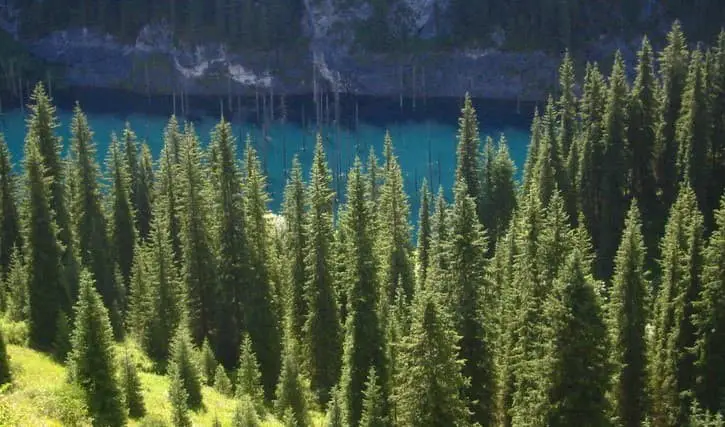
Schrenk’s spruce, an evergreen coniferous tree with a pyramidal shape and semi-upright branches, grows slowly to heights of up to 30 feet. It thrives in well-drained, moist soils with a slightly acidic pH, tolerating sandy or clay soil and brief droughts. Its ideal soil pH range is between 4.5-7.0, making it adaptable to a variety of environments. The tree prefers full sun but can tolerate light shade.
What sets Schrenk’s spruce apart is its unique growth pattern, featuring drooping lower branches and upward-pointing upper branches that create an umbrella-like shape. It’s also prized for its ornamental cones and grey-green foliage. One of the tree’s most notable features is its cold tolerance, able to withstand winter temperatures as low as -40°F.
Serbian spruce (Picea omorika)
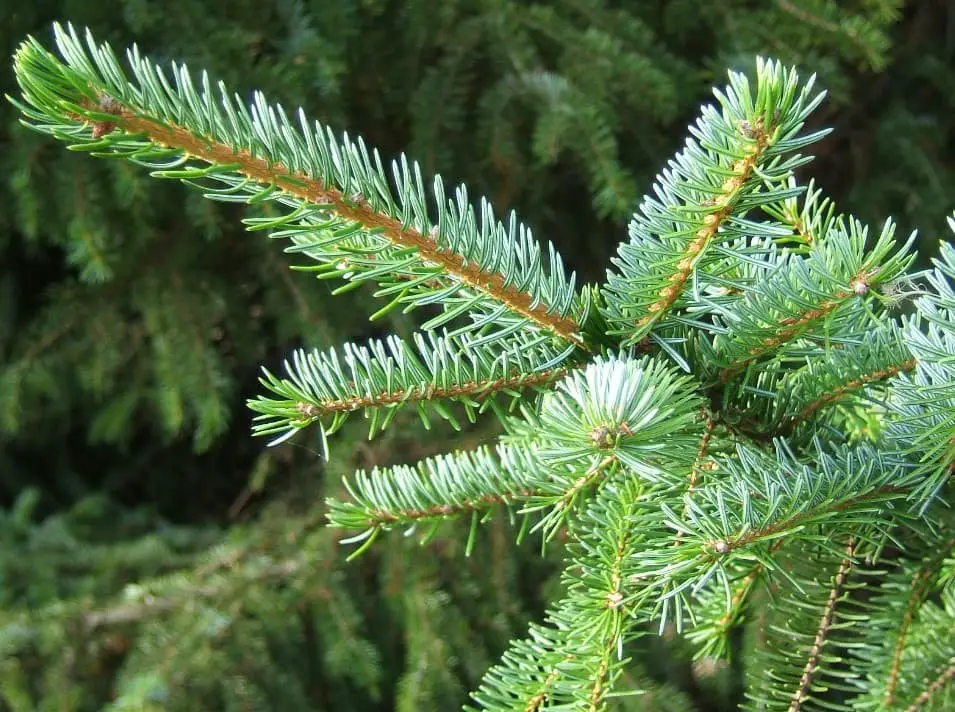
The Serbian spruce (Picea omorika) is a distinctive coniferous tree native to Serbia’s mountainous regions. Its pyramidal growth habit allows it to reach impressive heights of up to 80 feet when mature, showcasing its robustness. The tree thrives in moist, well-drained soils rich in organic matter, with a pH range of 5.5 to 7.0. It requires full sun to partial shade and can tolerate extremely cold temperatures as low as -40F in winter.
One of the Serbian spruce’s defining characteristics is its unique combination of long, flexible stems and needles. The tree’s gray-brown bark has a rough texture, while its light green needles have a striking silver-blue sheen. Furthermore, the cones are reddish-brown and can reach up to 1.5 inches in length, making them a notable feature.
Siberian spruce (Picea obovata)
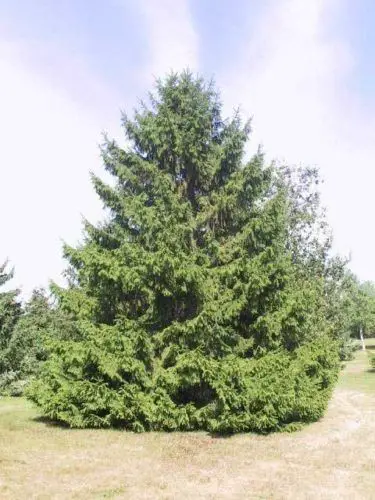
In the vast expanses of Siberia’s taiga and Northern Europe’s landscape, the Siberian spruce (Picea obovata) thrives as an evergreen coniferous tree. Its pyramidal growth habit is characterized by horizontal branches that droop towards their tips, creating a unique silhouette. The foliage is distinguished by stiff, silvery green needles with pointed tips.
This species of spruce is remarkably adaptable to various soil types, but excels in well-drained soils and thrives when planted in areas with ample moisture. Its impressive pH range tolerance, spanning from 4.5 to 7.5, makes it an ideal choice for both alkaline and acidic soils. To reach its full potential, the Siberian spruce requires partial shade, ideally receiving morning sun and afternoon shade.
While it can tolerate full sun if provided with sufficient moisture, this tree is most at home in a setting that balances light and shadow. One of its most striking features is its dark brown bark, which matures into attractive scaly plates as the tree ages. The foliage shines with a bright silvery green hue, while the cones turn reddish brown when they mature late in the summer.
As an ideal choice for windbreaks, screens, accent trees, or group plantings, the Siberian spruce also lends itself well to being planted as part of a forest. Its versatility and hardiness make it a popular selection among tree enthusiasts.
Sikkim spruce (Picea spinulosa)
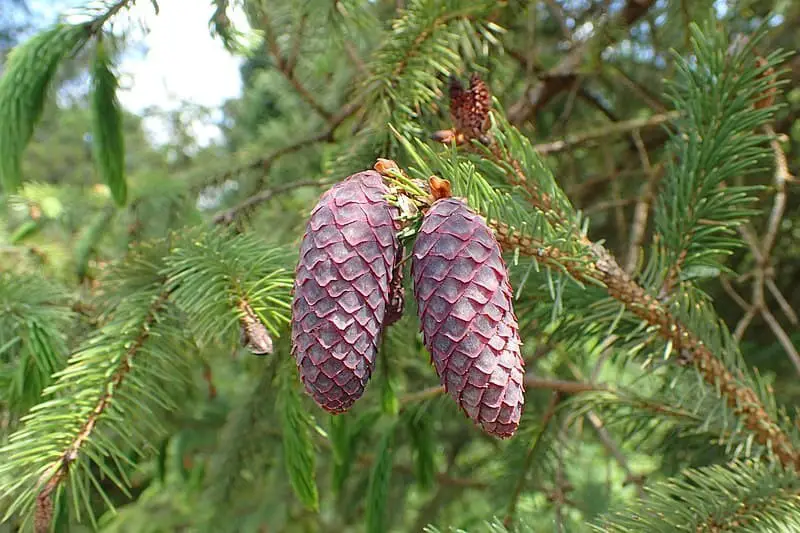
Sikkim spruce (Picea spinulosa) is a majestic evergreen conifer species endemic to the Himalayas. Measuring 20 to 40 meters in height, this medium-sized tree boasts a pyramidal crown and distinctive pendulous branches. The mature trees’ reddish brown bark is adorned with scaly texture, while the foliage consists of stiff, dark green needles that provide year-round structure.
Growth habits vary between its native range and more temperate climates; it grows at a slower pace in the Himalayas but accelerates in milder environments. Sikkim spruce thrives in moist, well-drained soil and flourishes under full sun to partial shade conditions.
Soil preferences dictate that this species requires a pH range of 5.5 to 7.0 for optimal growth.
It is not picky about light exposure, though; it can tolerate partial shade but may exhibit reduced foliage and minor frost damage in shaded environments.
One of Sikkim spruce’s most striking features is its reddish brown, scaly bark on mature trees. The needles are stiff and dark green, providing year-round structure. Its cones reach up to 1.5 inches in length and boast papery scales that can flake off easily.
The durable wood makes it an excellent choice for timber production, and its ornamental value is evident in parks and gardens where it is widely used.
Sitka Spruce (Picea sitchensis)
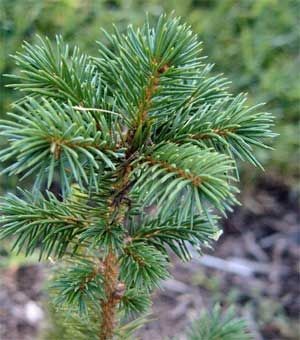
Sitka Spruce (Picea sitchensis) stands tall in the Pacific Northwest of North America, boasting an impressive stature and exceptional growth rate. This evergreen giant can reach towering heights of up to 200 feet, with a diameter of 4-6 feet at maturity. Its symmetrical crown is characterized by branches that ascend upward from the trunk, giving it a majestic appearance.
In terms of growth habit, Sitka Spruce tends towards a pyramidal form, although some trees may evolve into more rounded or columnar shapes over time. It experiences rapid growth during its first 15-20 years, before slowing down thereafter. The tree’s bark is remarkably thin and scaly, with a reddish-brown hue. The Sitka Spruce thrives in environments with moist, well-drained soils rich in organic matter.
While it can tolerate some waterlogging, it will not fare well in excessively wet or dry conditions. In terms of soil pH, this tree prefers a range between 4.5 and 8.0, but is surprisingly adaptable to slightly higher or lower levels without significant damage. In terms of light requirements, Sitka Spruce demands full sun for optimal growth, although it can also tolerate some shade. Its most striking features include its pendulous branchlets and attractive blue-green needles.
The cones are egg-shaped, boasting papery scales that evoke a shaggy mophead appearance.
Taiwan spruce (Picea morrisonicola)
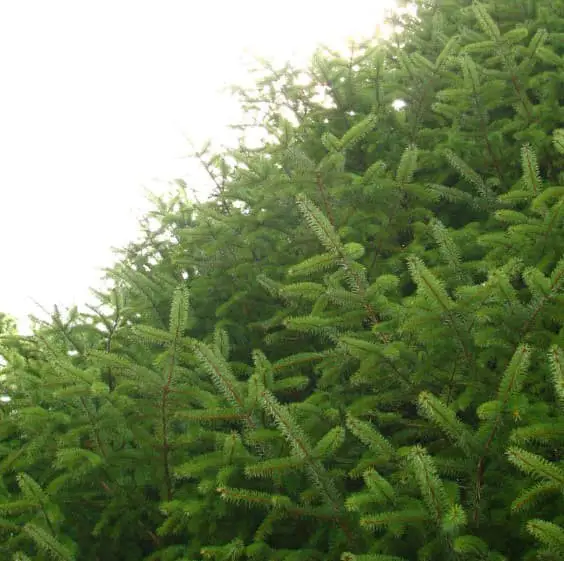
Taiwan spruce (Picea morrisonicola) is a native Taiwanese evergreen tree that thrives in mountainous regions. Its distinctively slow growth habit allows it to reach heights of up to 20 meters (66 feet), though it typically caps out at around 3-4 meters (10-13 feet). The tree’s foliage is characterized by stiff, dark green needles that grow in bundles of two or three, measuring 1-2 centimeters (0.4-0.8 inches) in length.
As the tree matures, its bark transforms from scaly and reddish-brown on younger trees to blocky, fissured, and gray. Taiwan spruce prefers well-drained soil with a slightly acidic pH range of 5.0-6.5, tolerating partial shade. Once established, it can withstand drought conditions and temperatures as low as -20°C (-4°F). Notably, the tree retains some green foliage during winter months, making it an attractive landscape feature. Its bark also provides a unique aesthetic appeal.
Additionally, Taiwan spruce is resistant to damage from deer and Japanese beetles, making it a reliable choice for gardeners. It can be used as a specimen tree, screen, windbreak, or even as a bonsai subject, offering versatility in its application.
Tiger-tail spruce (Picea torano)
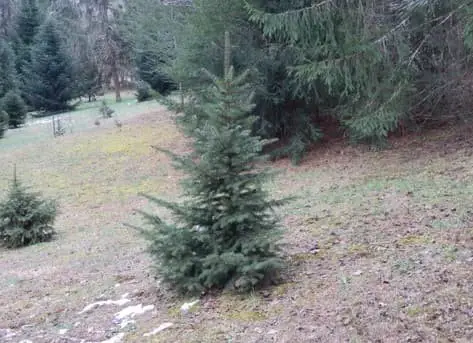
The tiger-tail spruce (Picea torano) is an evergreen tree endemic to Japan, boasting a distinctive pyramidal growth habit that can reach heights of up to 40 feet with a sprawling canopy spanning 15 feet. This species thrives in moist, well-drained soils and demands acidic conditions, with a pH range of 4.0 to 6.5. Tiger-tail spruce requires full sun to partial shade, although it can adapt to more shaded environments in warmer climates.
What sets the tiger-tail spruce apart is its extraordinary foliage, featuring bright green needles adorned with an unmistakable banding pattern that evokes the stripes of a tiger. As winter approaches, the leaves transform into a striking bronze-purple hue. The tree’s bark exhibits a reddish-brown color and a scaly texture, punctuated by shallow grooves that impart a tiger-like appearance. Mature cones measure 5-6 cm in length and transition from purple to brown as they ripen.
Veitch’s spruce (Picea neoveitchii)
Veitch’s Spruce (Picea neoveitchii) is a mid-sized coniferous tree that thrives in northern China, Japan, and Korea. This evergreen typically reaches heights of 25-35 feet, with a pyramidal shape and ascending branches that give it an airy appearance. The bark is remarkably thin, featuring a mottled grayish-brown color with small, scaly plates. Veitch’s Spruce has specific soil preferences, requiring moist, well-drained conditions to flourish.
It can tolerate a wide pH range, from acidic to slightly alkaline, making it adaptable to various environments. While full sun is ideal for optimal growth and health, the tree can still thrive in partial shade. The plant’s notable features include its lustrous, dark green needles that transition to a golden yellow hue during autumn. Its attractive red-brown cones add visual interest, while the thin, flaky bark and light-colored wood provide an interesting textural contrast.
Due to its rapid growth rate, Veitch’s Spruce is an excellent choice for screens, windbreaks, or specimen planting.
White Spruce (Picea glauca)
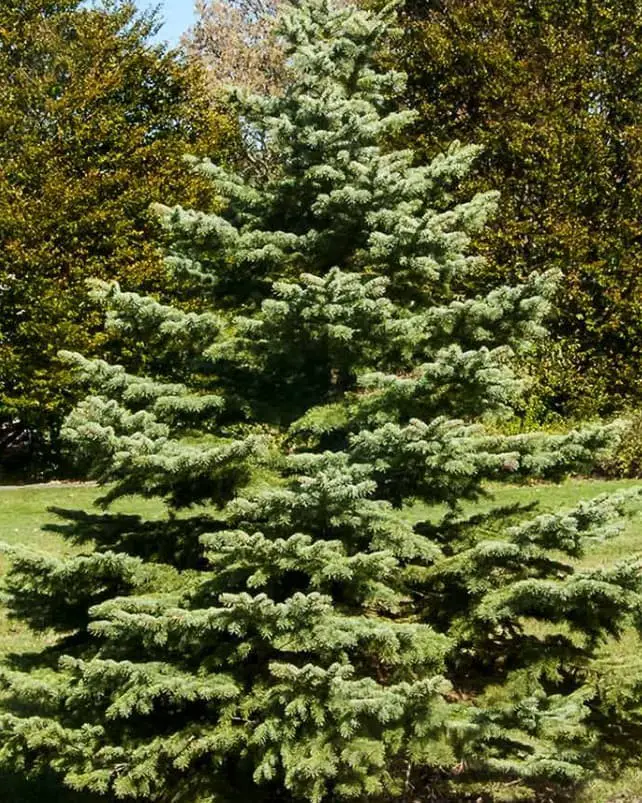
White Spruce (Picea glauca) stands tall as a large evergreen coniferous tree, reaching heights of 60-90 feet and living up to 300 years. Its unique characteristics include thin, gray-green needles that are short and sharp, scaly dark gray bark, and oval reddish-brown cones. Despite being a slow grower, White Spruce can reach its full size within 80 years, growing in an upright columnar shape with some specimens developing a more open or irregular form over time.
This species thrives in acidic, well-drained soils with a pH range of 4.5-6.0, and does best in moist, cool sites that receive full sun to partial shade. It’s also surprisingly tolerant of windy conditions. While it prefers full sun to partial shade, too much shade can hinder photosynthesis and stunt growth. One of the most notable features of White Spruce is its versatility. As an important timber species in North America, it’s used to create paper, furniture, and other wood products.
The foliage can also be used to create a soft evergreen hedge or windbreak in landscaping. Moreover, White Spruce is a popular choice as a Christmas tree species due to its attractive shape, texture, and color. Additionally, the wood is prized for making violins and other stringed instruments.
White Spruce Shrub (Picea glauca ‘Echiniformis’)
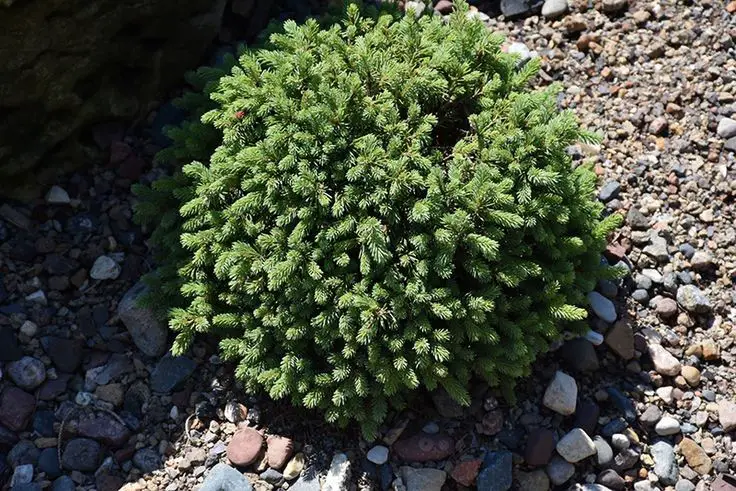
White Spruce Shrub (Picea glauca ‘Echiniformis’) boasts a slow-growing, evergreen profile that typically matures at 4 to 6 feet in height and spreads across 3 to 8 feet in width. Its upright pyramidal form is characterized by densely packed branches adorned with short, pointed needles boasting a striking blue-green coloration.
To foster optimal growth, this shrub thrives in moist yet well-drained soil conditions, with a preferred pH range of 4.5–7.0.
While it requires full sun or partial shade to reach its full potential, young trees may require additional protection from intense sunlight until they are established and able to withstand direct exposure.
One of the most distinctive features of White Spruce Shrub is its needle-like foliage, which bears a strong resemblance to that of a traditional spruce.
These short, pointed needles display a silvery blue hue that deepens in response to cold temperatures before reverting back to a lighter shade during warmer months.
The shrub’s bark is characterized by a thin, scaly texture with an orangish-brown coloration.
Wilson’s spruce (Picea wilsonii)
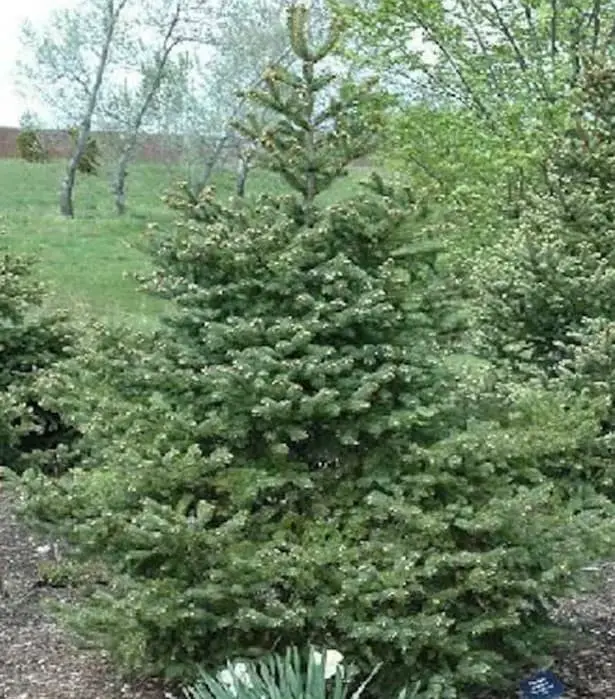
Wilson’s spruce (Picea wilsonii) is a distinctive evergreen conifer that typically takes on a conical shape as it grows. It can reach impressive heights of 30-50 feet, but has been known to soar up to 100 feet tall with a broad spread of 12-20 feet wide. The tree’s bark is light gray and textured, featuring ridges and furrows that give it a unique appearance. Its needles are a vibrant green to blue-green hue, measuring 1-2 cm in length.
This resilient species thrives in moist, well-drained soil rich in organic matter, with a pH range of 5.5 to 7.0 being optimal for growth. Wilson’s spruce also prefers full sun to partial shade, although it can tolerate some shade. One of its most striking features is the way its needles remain attached to the tree for up to three years before falling off, giving the tree an ever-changing appearance.
Additionally, this species is highly disease-resistant and can withstand temperatures as low as -46°F. Due to its hardiness, Wilson’s spruce is well-suited for a variety of landscapes. When planted in groupings, it makes an excellent windbreak or privacy screen. However, it’s essential to note that this tree does not respond well to excessive pruning and shearing, so such practices should be reserved for necessity only.
Furthermore, its roots may cause damage to sidewalks and other structures, making it best to plant the tree away from these areas.
Types of spruce trees in Canada.
In the vast Canadian forests, five distinct types of spruce trees can be found. These varieties include the White Spruce (Picea glauca), Black Spruce (Picea mariana), Red Spruce (Picea rubens), Norway Spruce (Picea abies), and Sitka Spruce (Picea sitchensis). The White Spruce, for instance, is the most common conifer in Canada and is typically found in northern regions, such as Labrador and Newfoundland. Its slender shape and blue-green needles make it easily recognizable.
On the other hand, the Black Spruce has a conical shape and dark green needles, thriving in moist soils that are prevalent in wetter parts of the country. The Red Spruce, native to the Appalachian Mountains, can be found in the Maritimes, central Canada, and has bright green needles that prefer drier conditions than its counterparts.
The Norway Spruce, introduced to Canada in the early 1800s for commercial purposes, boasts a pyramidal shape with bright green needles and excels in various soil types across the country. Lastly, the Sitka Spruce, the largest of all Canadian spruces, can reach heights of up to 200 feet, with deep blue-green needles growing on branches that droop down towards the ground. This species is native to western North America and is primarily found along Canada’s Pacific coast.
Types of spruce trees in Michigan.
In Michigan, three distinct species of spruce trees can be found: Black Spruce (Picea mariana), White Spruce (Picea glauca), and Norway Spruce (Picea abies). Each species exhibits unique characteristics that set them apart from one another. The Black Spruce is a smaller evergreen tree, typically growing between 10 and 20 feet tall with a conical shape, featuring short, stiff needles with a bluish-green hue and reddish-brown bark.
This species thrives in wetter areas, tolerating cold temperatures and partial shade. The White Spruce, on the other hand, is a medium-sized tree that reaches heights of 30 to 50 feet with an oval or conical shape. Its short, stiff needles are green in color, and its gray-brown scaly bark is well-suited for life in wet environments such as swamps and bogs. This species can also tolerate drier soils, making it a versatile choice for landscaping.
The Norway Spruce stands out as the largest of the three, capable of reaching heights of up to 100 feet when mature. Its long, stiff green needles are paired with gray-brown scaly bark that allows it to thrive in urban areas, parks, and larger landscapes. This hardy species tolerates cold temperatures and dry soils, making it an excellent choice for those looking to add a touch of elegance to their outdoor spaces.
Types of spruce trees in Colorado.
Colorado is home to five distinct species of spruce trees, each with unique characteristics that allow them to thrive in the state’s varied terrain. The Engelmann Spruce (Picea engelmannii) is found throughout Colorado, from the foothills of the Rocky Mountains to higher elevations, and grows at an elevation range of 1,000 to 11,000 feet. Its slightly bluish-green color and upright, conical shape make it a popular choice for timber production.
The Blue Spruce (Picea pungens) is also widespread throughout Colorado, found at elevations between 5,000 and 11,500 feet. Its needles are stiff and have a blue-green or silvery hue, making it an attractive option for windbreaks and timber production. In contrast, the Black Hills Spruce (Picea glauca var. densata) is native to the Black Hills region of Colorado, Wyoming, and South Dakota, and grows at elevations between 8,000 and 10,000 feet.
Its shorter needles with a blue-green color set it apart from other spruces. The Colorado White Spruce (Picea pungens ssp. pungens) is found in the mountains of Colorado, Wyoming, and Utah, growing at elevations between 8,000 and 12,000 feet. Its dense foliage and bright green color make it a popular choice for reforestation projects due to its fast growth rate and ability to withstand harsh weather conditions. Lastly, the Southwestern White Spruce (Picea pungens ssp.
glauca) is native to Colorado and also found in Utah, New Mexico, and Arizona. It grows at elevations between 6,000 and 12,000 feet and has a blue-green needle color with shorter needles than other spruces. Its ability to tolerate drier conditions makes it a popular choice for windbreaks and timber production.
Types of spruce trees in Wisconsin.
Wisconsin’s landscape is characterized by a diverse array of spruce tree species, with populations scattered throughout both the northern and southern regions of the state. Among the most common species found in Wisconsin are White Spruce (Picea glauca), Black Spruce (Picea mariana), Norway Spruce (Picea abies), and Blue Spruce (Picea pungens). While White Spruce tends to dominate the northern areas, the other three species can be found throughout Wisconsin.
These spruces play a vital role in supporting local wildlife, serving as crucial food sources and shelter for various species. Additionally, they are important providers of timber, which can be harvested sustainably to bolster local economies. The evergreen foliage of these trees also lends a unique aesthetic appeal to Wisconsin’s forests year-round, providing shade and habitat for numerous animals.
With lifespans measured in decades, if not centuries, spruce trees have become integral components of Wisconsin’s ecological, economic, and aesthetic landscapes.
Types of spruce trees in Minnesota.
Minnesota is renowned for its diverse range of spruce trees, boasting three primary varieties: White Spruce (Picea glauca), Black Spruce (Picea mariana), and Blue Spruce (Picea pungens). The most ubiquitous species is the White Spruce, which thrives in dense, conical formations that can soar to impressive heights of 80-100 feet. In contrast, Black Spruces tend to inhabit wetter, boggy environments, where they can grow up to 50 feet tall.
Meanwhile, Blue Spruces stand out with their striking silvery-blue hue, making them a popular choice for landscaping purposes. Typically, these trees reach elevations of around 40 feet.
Tips and Advice for Selecting and Caring for Spruce Trees and Shrubs
To cultivate thriving spruce trees and shrubs, start by planting them in well-drained soil that is rich in organic matter. Avoid areas with standing water or poor drainage, as this can lead to root rot. Instead, provide your newly planted spruces with deep but infrequent watering (once a week) to encourage deep rooting. In times of drought, supplement natural rainfall with additional water to ensure the plants’ survival.
In late winter or early spring, prune your spruce trees and shrubs before new growth begins to emerge. Remove any dead or diseased branches, as well as thin out overly dense areas to promote better air circulation and prevent disease from taking hold.
Fertilize your spruce trees and shrubs at least once a year, but avoid fertilizing in late summer or fall, as this can encourage tender new growth that may be susceptible to winter damage.
By keeping your plants healthy through proper care and maintenance, you’ll be better equipped to detect any signs of pest infestations or disease, allowing you to treat these issues quickly and prevent long-term damage or death.
FAQs about Types of Spruce Trees and Shrubs:
What are the most popular types of spruce trees?
Among the numerous species of spruce trees, several stand out for their popularity. The white spruce, Norway spruce, Sitka spruce, Black Hill spruce, and Colorado Blue spruce are particularly well-known and widely cultivated.
Are there any specific types of spruce trees that are suitable for cold climates?
While Norway’s climate is certainly unforgiving, it’s a perfect haven for white spruce trees. These hardy trees have adapted to thrive in the country’s frigid conditions, where temperatures can plummet as low as -40 degrees Fahrenheit.
What types of shrubs are related to spruce trees?
Within the realm of evergreen conifers, junipers and yews share a common bond with their spruce counterparts. This familial connection is evident in their diverse range of shapes and sizes, which can manifest as compact shrubs or towering trees, showcasing the adaptability and resilience of these species.
Are there any types of spruce trees or shrubs that produce edible fruits?
While many people may not know it, certain types of juniper trees bear edible fruits in the form of berries. These berries are often used to add flavor and zest to various dishes, typically in the form of sauces and seasonings. Interestingly, yew trees also produce small red berries that can be consumed raw or cooked, offering a sweet and tangy treat.
Are there any specific types of spruce trees that are better suited to wet climates?
While Norway spruce and Sitka spruce trees thrive in wet environments due to their adaptability to high levels of rainfall, Black hill spruces have a slightly different story. While they too can tolerate wet conditions, they generally prefer more moderate climate conditions that are not overly saturated with water.
How many different types of spruce trees are there?
With a remarkable diversity, there are over 35 distinct species of spruce trees globally. Among these, some of the most widely recognized varieties include the white spruce, Norway spruce, Sitka spruce, black hill spruce, and Colorado blue spruce.
Are there any specific types of shrubs that can tolerate windy conditions?
When it comes to selecting shrubs for windy locations, junipers are an excellent choice. Their dense foliage provides a natural barrier against harsh winds, making them well-suited for areas prone to strong gusts. Yews can also thrive in windy conditions, but they require more careful placement – ideally, in sheltered areas that provide some protection from the elements.
Related Posts
From diverse online plant nurseries to sprawling evergreen forests, the world of trees is vast and fascinating. Whether you’re looking to cultivate your own arboreal haven or pursue a career as an arborist, understanding the variety of tree species available is crucial. For instance, did you know that certain types of trees can significantly boost your property’s appeal? Conversely, strategically removing trees can also have a positive impact.
In addition to exploring the aesthetic benefits of trees, we’ll delve into the world of tree care and provide guidance on how to become an arborist. We’ll also explore specific growing tips for unique species like the Lady Palm and offer advice on cultivating organic blueberry plants in your own garden.



